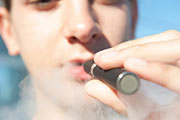- Skip Storing This Everyday Product in the Fridge Door
- Green Tea + B3 Pairing May Boost Brain Health
- Navigating Your Midlife Crisis: Embracing New Possibilities
- City Raccoons Showing Signs of Domestication
- Mapping the Exposome: Science Broadens Focus to Environmental Disease Triggers
- One Week Less on Social Media Linked to Better Mental Health
- Your Brain Changes in Stages as You Age, Study Finds
- Some Suicide Victims Show No Typical Warning Signs, Study Finds
- ByHeart Formula Faces Lawsuits After Babies Sickened With Botulism
- Switch to Vegan Diet Could Cut Your Greenhouse Gas Emissions in Half
E-Cigarette Use May Be Rising Among Teens


Nearly a third of Hawaiian high school students have tried e-cigarettes, new research suggests.
This finding reflects a growing trend of American teens flocking to the nicotine inhalation devices, according to public health experts.
The overall rate of e-cigarette use in the new study is higher than found in mainland U.S. studies over the past several years. But e-cigarette use is “accelerating very rapidly” across the nation, according to Dr. Norman Edelman, senior consultant for scientific affairs at the American Lung Association.
An e-cigarette is a device that turns nicotine, flavorings and other chemicals into an inhalable vapor. Many e-cigarettes are designed to resemble tobacco cigarettes, according to the U.S. Food and Drug Administration.
The FDA is still reviewing evidence about the safety of e-cigarettes, but the agency has proposed banning sales of the devices to minors. According to the FDA’s website, the devices still haven’t been fully studied and it’s impossible to know their potential risks or even how much nicotine is being inhaled during use.
The new study surveyed more than 1,900 teens in Hawaii. The average age was between 14 and 15 years old. The teens were in ninth and 10th grades, and from both public and private schools, according to the study. The survey assessed e-cigarette and cigarette use, alcohol and marijuana use, and psychosocial risk factors for substance use.
The researchers also found that 12 percent reported using both e-cigarettes and tobacco cigarettes, while 17 percent had used e-cigarettes only and 3 percent used cigarettes only.
Study author Thomas Wills, interim director of the Cancer Prevention and Control Program at University of Hawaii Cancer Center, said his team was surprised by the research results in several ways.
“We had thought that persons who used e-cigarettes would look pretty much like smokers on the psychosocial variables we measured, like sensation seeking, impulsivity and peer smoking,” he said. “It turned out that the students who only used e-cigarettes had a lower risk profile than smokers and dual users — persons who use both cigarettes and e-cigarettes.”
Since teens surveyed who only used e-cigarettes ranked intermediate in levels of risk and protective factors between nonusers and those using both cigarettes and e-cigarettes, Edelman questioned whether e-cigarettes were effectively “recruiting” low-risk children to tobacco products.
“Kids will try any psychoactive device that seems interesting,” added Edelman, also professor of preventive and internal medicine at State University of New York at Stony Brook. “But the American Lung Association is very concerned about that because we think one of the major deleterious effects of e-cigarettes is hooking a whole generation of kids on this very addictive substance that is nicotine.”
He noted that e-cigarettes are only one of many available “nicotine delivery devices,” which also include items resembling pens or USB drives that release puffs of nicotine vapor.
Reporting “having used” e-cigarettes can mean a range of usage, Wills said. The 29 percent of Hawaiian teen participants who tried e-cigarettes includes 8 percent who tried them only once or twice, he said, but 21 percent have used them up to weekly or daily.
Wills said his research is consistent with the idea that e-cigarettes are helping to draw lower-risk teens toward smoking, and every recent study shows there are many dual cigarette/e-cigarette users among teenagers.
Edelman said the purchase of e-cigarettes and other nicotine delivery devices should be restricted to adults and the products should be banned from use in public places, as cigarettes often are.
“Parents have to make it clear to kids that these things are not necessarily safe,” he said, “and to live a full and complete life, it would be good if they were drug-free.”
Results of the study were published online on Dec. 15 in the journal Pediatrics.
More information
The U.S. National Library of Medicine offers more information on nicotine and tobacco.
Source: HealthDay
Copyright © 2025 HealthDay. All rights reserved.










